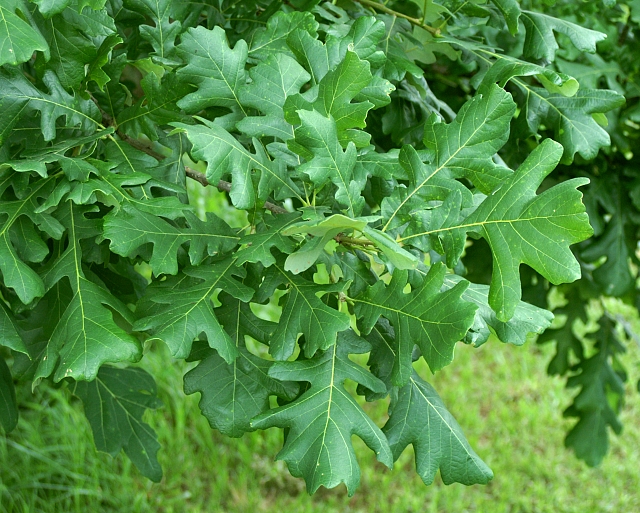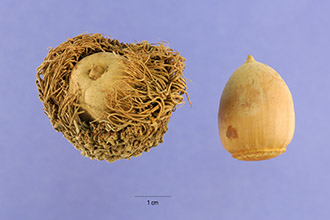Quercus macrocarpa
KWER-kusmmagh-KROH-car-puh
Michaux
Bur Oak/Mossy-Cup Oak


"Bur Oak is a majestic tree of the tallgrass prairie that once covered central North America. It grows best in deep limestone soils of riverbanks and valleys, but it will adapt to many different environments. It has a long taproot which makes it hard to transplant, but it is very drought-tolerant. It is also fast growing and long-lived. Bur oak is noted for its very large leaves and acorns. The leaves are from one-half to one foot long, and acorns can be as large as two inches long and wide, enclosed in a cup with fringe on the edge. It casts deep shade."
"Bur oak is widely distributed throughout much of the north-central United States and the eastern Great Plains. It occurs from southern New Brunswick and New England westward to the Dakotas and southeastern Montana, and south to Texas, Arkansas, and Tennessee. Bur oak is locally common in Louisiana and Alabama. Quercus macrocarpa var. olivaeformis is largely restricted to Iowa, Minnesota, South Dakota, and North Dakota. Quercus macrocarpa var. depressa occurs mostly along the western margin of the Great Plains." http://www.fs.fed.us/database/feis/plants/tree/quemac/
This medium to large deciduous tree (height: sixty to seventy feet; width: sixty to seventy feet) likes full sun, tolerates high temperatures, requires minimal amounts of moisture, grows in most soils and is hardy to USDA Hardiness Zone: 3.
Catkins, four to six inches long, appear in the spring and result in large acorns up to two inches around, with a fringed cup.Image of acorns courtesy of Steve Hurst @ USDA-NRCS PLANTS Database | 
|
The Natural History Museum reports Quercus macrocarpa as a host for the following butterfly species:
Erynnis brizo
Erynnis juvenalis
Satyrium calanus
Satyrium edwardsii
The Natural History Museum reports Quercus macrocarpa as a host for the following Saturniidae species:
Actias luna
Anisota manitobensis
Anisota senatoria
Anisota virginiensis
Antheraea pernyi
Antheraea polyphemus
Automeris io
Eacles imperialis
Hemileuca slosseri
Hyalophora cecropia
The Natural History Museum reports Quercus macrocarpa as a host for the following Sphingidae species:
Ceratomia amyntor
The Natural History Museum reports Quercus macrocarpa as a host for the following Catocala species:
Catocala aholibah
Catocala amica
Catocala coccinata
Catocala delilah
Catocala ilia
Catocala micronympha
Catocala ophelia
Catocala verrilliana
Tree information is from Aggie Horticulture
This page designed and maintained by Bill Oehlke as an extension of the
World's Largest Saturniidae Site, a private worldwide silkmoth site,
Caterpillars Too!, a private North American butterfly site featuring images of caterpillars,
Sphingidae of the Americas, a free public access site with pictures and information about the Sphingidae (Hawkmoths) of the Americas.
North American Catocala, a free public access site with pictures and information about the Catocala (Underwing moths) of Canada and the United States.
Caterpillar images of most of the species mentioned above can be accessed from individual species files on the respective sites.
Use your browser "Back" button to return to the previous page.